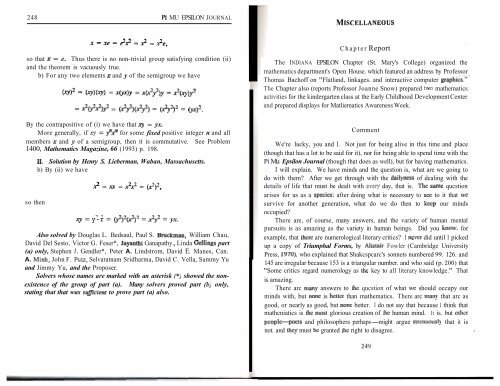Vol. 10 No 3 - Pi Mu Epsilon
Vol. 10 No 3 - Pi Mu Epsilon
Vol. 10 No 3 - Pi Mu Epsilon
- No tags were found...
Create successful ePaper yourself
Turn your PDF publications into a flip-book with our unique Google optimized e-Paper software.
248 <strong>Pi</strong> MU EPSILON JOURNALso that x = e. Thus there is no non-trivial group satisfying condition (ii)and the theorem is vacuously true.b) For any two elements x and y of the semigroup we have"22= ^ m y 2 = (2y2)(y2) = (ry ) = (w)2.By the contrapositive of (i) we have that xy = yx.More generally, if xy = y Y for some fixed positive integer n and allmembers x and y of a semigroup, then it is commutative. See Problem1400, Mathematics Magazine, 66 (1993) p. 198.so then11. Solution by Henry S. Lieberman, Waban, Massachusetts.b) By (ii) we have7 " 1 1 1 2xy = y-r = @-)-(A?) = 2y2 = yx.Also solved by Douglas L. Bedsaul, Paul S. Bruckman, William Chau,David Del Sesto, Victor G. Feser*, Jayanthi Ganapathy , Linda Gellings part(a) only, Stephen I. Gendler*, Peter A. Lindstrom, David E. Manes, Can.A. Minh, John F. Putz, Selvaratnam Sridharma, David C. Vella, Sammy Yuand Jimmy Yu, and the Proposer.Solvers whose names are marked with an asterisk (*) showed the nonexistenceof the group of part (a). Many solvers proved part (b) only,stating that that was sufficient to prove part (a) also.Chapter ReportThe INDIANA EPSILON Chapter (St. Mary's College) organized themathematics department's Open House. which featured an address by ProfessorThomas Bachoff on "Flatland, linkages. and interactive computer graphi&"--The Chapter also (reports Professor Joanne Snow) prepared hvo mathematicsactivities for the kindergarten class at the Early Childhood Development Centerand prepared displays for Matliematics Awareness Week.CommentWe're lucky, you and I. <strong>No</strong>t just for being alive in this time and place(though that has a lot to be said for it), nor for being able to spend time with the<strong>Pi</strong> <strong>Mu</strong> <strong>Epsilon</strong> Journal (though that does as well), but for having mathematics.I will explain. We have minds and the question is, what are we going todo with them? After we get through with the dailyness of dealing with thedetails of life that must be dealt with event day, that is. The same qucstionarises for us as a species: after doing what is necessary to scc to it that wesurvive for another generation, what do we do then to keep our mindsoccupied?There are, of course, many answers, and the variety of human mentalpursuits is as amazing as the variety in human beings. Did you know, forexample, that there are numerological literary critics? I never did until I pickedup a copy of Triumphal Forms, by Alistair Fowler (Cambridge UniversityPress, 1970), who explained that Shakcspcarc's sonnets numbered 99. 126. and145 are irregular because 153 is a triangular number. and who said (p. 200) that"Some critics regard numerology as the key to all literary knowledge." Thatis amazing.There arc many answers to the qucstion of what \vc should occupy ourminds with, but none is better than mathematics. There arc mail! that arc asgood, or nearly as good, but none better. I do not say that because 1 think thatmathcniatics is the most glorious creation of the human mind. It is. but oilierpeople~pocts and philosophers perhaps-might argue strcnuousI> that it isnot. and they must be granted thc right to disagree. .
















